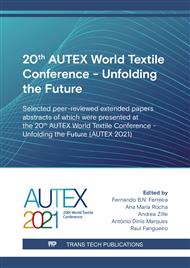[1]
Tàpias, M., Ralló, M., Escofet, J., Algaba, I., Riva, A. Objective measure of woven fabric's cover factor by image processing. Textile research journal, 80.1, (2010) 35-44.
DOI: 10.1177/0040517509104471
Google Scholar
[2]
Tàpias, Montserrat, Jaume Escofet, and Miquel Ralló. Cover factor determination by means of reflectance measurement in translucent textile webs. AIP Conference Proceedings. American Institute of Physics, 992(1) (2008).
DOI: 10.1063/1.2926788
Google Scholar
[3]
Peirce, Frederick Thomas. 5—The geometry of cloth structure. Journal of the Textile Institute Transactions, 28.3, (1937) 45-96.
Google Scholar
[4]
Hamilton, J. B. 7—A general system of woven-fabric geometry. Journal of the Textile Institute Transactions, 55.1, (1964) 66-82.
DOI: 10.1080/19447026408660209
Google Scholar
[5]
Havlová, Marie. Model of vertical porosity occurring in woven fabrics and its effect on air permeability. Fibres & Textiles in Eastern Europe (2014).
Google Scholar
[6]
Zupin, Živa, Aleš Hladnik, and Krste Dimitrovski. Prediction of one-layer woven fabrics air permeability using porosity parameters. Textile Research Journal 82.2 (2012) 117-128.
DOI: 10.1177/0040517511424529
Google Scholar
[7]
Gotipamul, R. L., Dandgole, P. B., Dudagi, I. B., Prasad, J., Surwase, V. S., Yuvraj, T., & Deori, R. Effect of cover factor and weave factor on flammability characteristics of 100% cotton fabric. Melliand International, 20.1 (2014).
Google Scholar
[8]
Baltušnikaitė, J., Šuminskienė, R., Milašius, R. Influence of Woven Fabrics Structure upon Flammability Properties. Materials Science (MEDŽIAGOTYRA), 12, (2006) 167-70.
Google Scholar
[9]
Kostajnšek, K., Dimitrovski, K. Use of Extended Cover Factor Theory in UV Protection of Woven Fabric. Polymers, 13(8), (2021) 1188.
DOI: 10.3390/polym13081188
Google Scholar
[10]
Dubrovski, P. D., Golob, D. Effects of woven fabric construction and color on ultraviolet protection. Textile Research Journal, 79(4), (2009) 351-359.
DOI: 10.1177/0040517508090490
Google Scholar
[11]
Gabrijelčič, H., Urbas, R., Sluga, F., Dimitrovski, K. Influence of fabric constructional parameters and thread colour on UV radiation protection. Fibres & Textiles in Eastern Europe, 17.1, (2009) 46-54.
Google Scholar
[12]
Epps, H. H., Leonas, K. K. The relationship between porosity and air permeability of woven textile fabrics. Journal of testing and evaluation, 25.1, (1997) 108-113.
DOI: 10.1520/jte11330j
Google Scholar
[13]
Zupin, Ž., Hladnik, A., Dimitrovski, K. Prediction of one-layer woven fabrics air permeability using porosity parameters. Textile Research Journal, 82.2, (2012) 117-128.
DOI: 10.1177/0040517511424529
Google Scholar
[14]
Xu, G., Wang, F. Prediction of the permeability of woven fabrics. Journal of Industrial Textiles, 34.4, (2005) 243-254.
DOI: 10.1177/1528083705051455
Google Scholar
[15]
Wardiningsih, W., Troynikov, O. Influence of cover factor on liquid moisture transport performance of bamboo knitted fabrics. Journal of the Textile Institute, 103.1, (2012) 89-98.
DOI: 10.1080/00405000.2011.552253
Google Scholar
[16]
Zhang, H., Liu, F., Wang, J., Zhu, C. Effects of fabric weave and cover factor on moisture transfer ability of moisture absorbent and fast drying fabric. Journal of textile research, 5 (2008).
Google Scholar
[17]
Onal, L., Candan, C. Contribution of fabric characteristics and laundering to shrinkage of weft knitted fabrics. Textile Research Journal, 73.3, (2003)187-191.
DOI: 10.1177/004051750307300301
Google Scholar
[18]
Baird, K. Felting shrinkage and dimensional properties of hand-knitted wool fabrics. Textile Research Journal, 40.12, (1970) 1064-1069.
DOI: 10.1177/004051757004001203
Google Scholar
[19]
Szmyt, J., Mikolajczyk, Z. Light transmission through decorative knitted fabrics in correlation with their fabric cover. AUTEX Research Journal, 10.2, (2010) 44-48.
Google Scholar
[20]
Militky, J., Travnickova, M., Bajzik, V. Air permeability and light transmission of weaves. International journal of clothing science and technology (1999).
DOI: 10.1108/09556229910276331
Google Scholar
[21]
Soltani, P., Zarrebini, M. Acoustic performance of woven fabrics in relation to structural parameters and air permeability. Journal of the Textile Institute, 104.9, (2013) 1011-1016.
DOI: 10.1080/00405000.2013.771427
Google Scholar
[22]
Shanbeh, Mohsen, et al. Analysis of shear characteristics of woven fabrics and their interaction with fabric integrated structural factors. Journal of Engineered Fibers and Fabrics 14 (2019): 1558925019867520.
DOI: 10.1177/1558925019867520
Google Scholar



